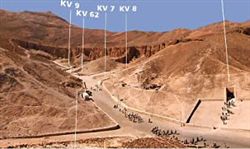
Die königliche Nekropole des Neuen Reiches auf dem Westufer des Nil gegenüber von Theben. Tatsächlich handelt es sich um zwei miteinander verbundene Täler, wobei das östliche das bedeutendere ist. Hier liegen die Königsgräber der 18.-20. Dynastie sowie die Gräber einiger weniger nichtköniglicher Personen. Das andere, westliche Tal enthält vier Gräber. Insgesamt 62 Gräber haben eine offizielle Nummer erhalten, und es gibt mindestens drei nichtnumerierte Gräber. Nicht alle numerierten Gräber sind Königsgräber; einige wurden für Mitglieder des Königshauses gebaut wie das Mitte der 90er Jahre wiederentdeckte Grab Nr. 5, das den Söhnen Ramses' II. gehört. Einige Gräber gehören auch hohen Beamten, etwa dem Wesir Amenemope (Grab 48). Das älteste Grab ist möglicherweise dasjenige, das Thutmosis I. zugewiesen wird (Grab 38), obwohl manche Leute glauben, daß das anonyme Grab 39 Amenophis I. gehörte. Das jüngste Grab ist dasjenige von Ramses XI. Alle Gräber bestehen aus einem oder mehreren in den Fels gehauenen Räumen, die durch Korridore miteinander verbunden sind. Die ursprüngliche Vorstellung war, das Grab nach der Bestattung des toten Königs zu versiegeln und den Eingang unter Geröll zu verbergen. Auf diese Weise hoffte man der Grabräuberei zu entgehen. Die Folge war, daß die königlichen Totentempel nicht mehr an das Grab angeschlossen waren, sondern weit entfernt am Wüstenrand lagen. Die Grabarchitektur zeigt eine klare Entwicklung. Die ältesten Gräber haben beispielsweise einen Korridor, der einen Knick von 90° beschreibt und eine wie eine Kartusche geformte Grabkammer. Die Totentexte auf den Wänden entstammen gewöhnlich dem Amduat. Spätere Gräber bestehen aus einer Reihe von Räumen, die durch gerade Korridore miteinander verbunden sind. Das erste derartige Grab war das des Echnaton in El-`Amarna. Die ältesten in dieser Weise angelegten Gräber im Tal der Könige sind die des Eje und des Haremheb. Das Pfortenbuch erscheint erstmals auf den Wänden des Grabes des Haremheb. Spätere Gräber enthalten auch andere Totentexte und Darstellungen. Weiterhin haben verschiedene Gräber eine astronomische Decke. Das bekannteste Grab im Tal der Könige ist vermutlich das des Tutanchamun, obwohl es sehr klein ist. Wahrscheinlich war es gar nicht für ihn bestimmt, sondern für einen hohen Beamten (Eje?), wurde aber nach dem plötzlichen Tod des Tutanchamun für ihn hergerichtet. Es wird vermutet, daß das ursprünglich für Tutanchamun gedachte Grab das Grab Nr. 23 war, das später von Eje benutzt wurde. Als in der 21. Dynastie die Gräber regelmäßig von Grabräubern ausgeplündert wurden, nahmen Priester einige der dort begrabenen Könige aus ihren Gräbern und bestatteten sie zusammen in einem Versteck bei Deir el-Bahari und im Grab von Amenophis II. Sie wurden erst Ende des 19. Jahrhunderts entdeckt.